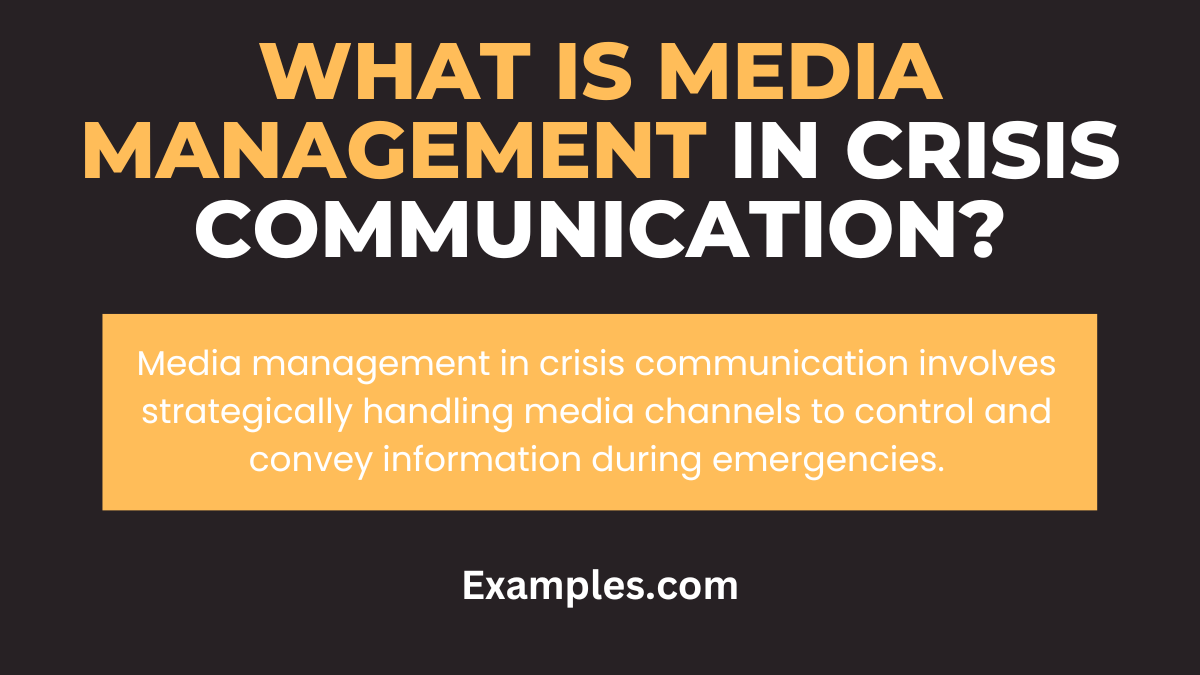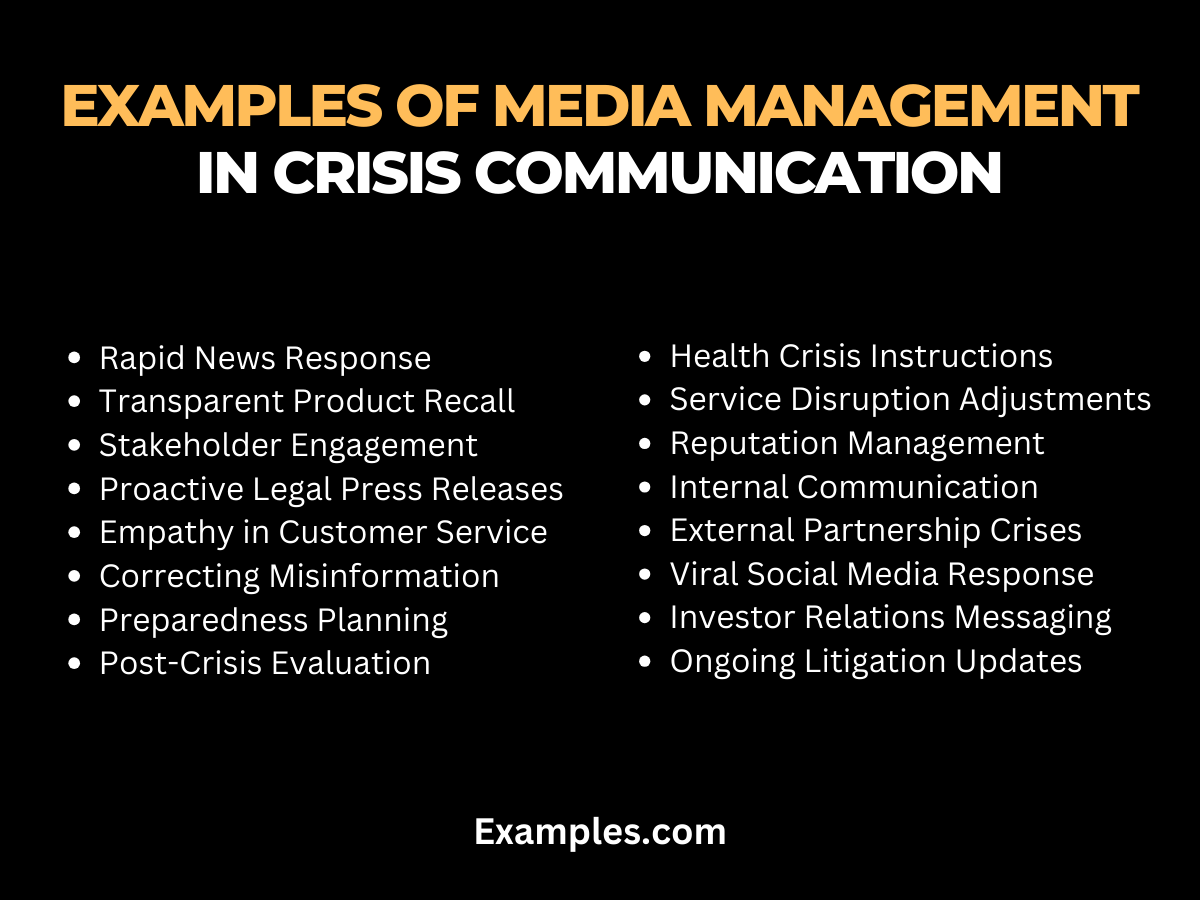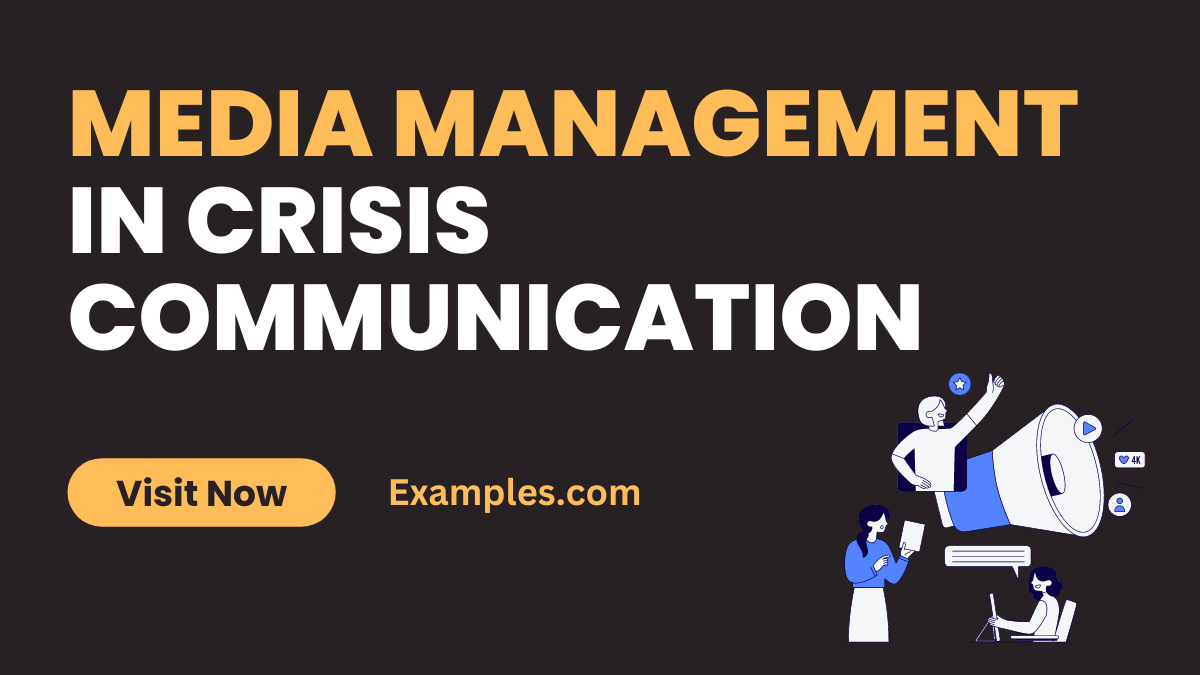19+ Media Management in Crisis Communication Examples
In the realm of Crisis Communication, mastering media management is pivotal. This comprehensive guide delves into the nuances of effectively handling media during challenging times. Media management in crisis communication involves strategic planning and execution to ensure clear, consistent messaging. It’s about controlling the narrative, engaging with various stakeholders, and responding swiftly to media inquiries. This guide, enriched with practical examples, will equip you with the skills to manage media relations proactively and reactively, ensuring your message resonates accurately and positively during a crisis.
What is Media Management in Crisis Communication?

Media Management in Crisis Communication refers to the strategic process of controlling and guiding the flow of information during a crisis. It involves coordinating with the media to disseminate clear, accurate, and timely information to the public. Effective media management helps organizations maintain their reputation, mitigate misinformation, and provide crucial updates during emergencies.
What is the Best Example of Media Management in Crisis Communication?

One of the best examples of Media Management in Crisis Communication is the response to the 9/11 attacks. Authorities rapidly engaged with media outlets to provide factual updates, demonstrating Transparent Communication in Crisis Communication. The focus was on delivering accurate information, maintaining public calm, and dispelling rumors. This incident highlights the importance of a well-prepared media management strategy, emphasizing rapid response, factual accuracy, and stakeholder engagement.
20 Examples of Media Management in Crisis Communication

Effective media management in crisis communication is crucial for maintaining public trust and managing reputational risks. This involves deploying targeted strategies to handle information dissemination and stakeholder interactions during critical times. Key aspects like crisis communication strategies, transparent messaging, and rapid response play a pivotal role in shaping outcomes.
- Rapid Response to Breaking News: Immediately address breaking news to control narratives. “We are aware of the situation and are actively investigating to provide accurate information.”
- Transparent Updates During a Product Recall: Share clear, honest updates during product recalls. “Our priority is customer safety. We’re recalling [product] due to [reason], and here’s how we’re addressing it.”
- Consistent Messaging During a Natural Disaster: Maintain uniform messages across platforms during crises like earthquakes. “Our emergency teams are mobilized and working closely with local authorities to provide aid.”
- Stakeholder Engagement During Financial Downturns: Actively involve stakeholders during financial crises. “We’re committed to transparency and will keep you updated as we navigate these challenges.”
- Proactive Press Releases in Legal Disputes: Send preemptive press releases in legal situations. “We respect the legal process and are cooperating fully with ongoing investigations.”
- Social Media Monitoring During Public Relations Crises: Vigilantly monitor and respond to social media chatter during PR crises. “We hear your concerns and are taking steps to address them.”
- Empathy in Customer Service Failures: Show empathy in responses to customer service failures. “We sincerely apologize for the inconvenience and are working to resolve this issue swiftly.”
- Ensuring Factual Accuracy in Misinformation Scenarios: Correct misinformation with factual updates. “To clarify, here are the accurate details regarding the recent incident.”
- Preparedness Planning Announcements: Publicize crisis preparedness efforts. “We have implemented enhanced measures to ensure safety and reliability.”
- Post-Crisis Evaluation Communication: Share findings and improvements post-crisis. “Following our review, we’re implementing changes to prevent future occurrences.”
- Instructional Communication During a Health Crisis: Provide clear instructions in health emergencies. “Please follow these guidelines to ensure your safety and well-being.”
- Adjustment Communication in Service Disruptions: Communicate adjustments during service disruptions. “We’re adjusting our services to better serve you during this time.”
- Reputation Management after Negative Publicity: Address negative publicity with strategic communication. “We are committed to upholding our values and have taken the following steps…”
- Internal Communication During Restructuring: Keep employees informed during organizational changes. “Your role is vital, and here’s how the changes affect our team.”
- External Communication in Partnership Crises: Address external stakeholders in partnership breakdowns. “We’re working closely with our partners to resolve this matter.”
- Social Media Responses to Viral Challenges: Tackle viral social media issues head-on. “We’re aware of the viral issue and here’s our stance on it.”
- Stakeholder-Specific Messages in Investor Relations: Tailor messages for investors during financial updates. “Our strategic plan addresses current market challenges and future growth.”
- Post-Crisis Community Outreach: Engage with the community after crises. “We’re committed to supporting our community’s recovery and resilience.”
- Proactive Updates in Ongoing Litigation: Keep stakeholders informed in ongoing legal cases. “While we can’t comment on specifics, we assure transparency at each step.”
- Crisis Communication in Cybersecurity Breaches: Communicate effectively during cybersecurity incidents. “We’re addressing the breach with utmost urgency and here’s what it means for you.”
Role of Media Management in Crisis Communication
Media management plays a crucial role in crisis communication by shaping how information is disseminated and perceived. Here are eight key points highlighting its importance:
- Controlling the Narrative: Media management helps control the crisis narrative, focusing on conveying accurate and consistent messages to the public.
- Rapid Dissemination of Information: In a crisis, timely information is critical. Media management ensures rapid dissemination of updates across various channels.
- Public Perception Management: It helps in shaping public perception by highlighting positive actions and responses to the crisis.
- Stakeholder Engagement: Effective media management involves engaging with stakeholders, keeping them informed, and addressing their concerns.
- Crisis Mitigation: By providing factual and transparent information, media management helps mitigate the impact of the crisis.
- Feedback Loop Creation: It creates a feedback loop, allowing organizations to gauge public reaction and adjust their strategies accordingly.
- Reputation Management: Maintaining a positive image during a crisis is vital, and media management plays a key role in reputation management.
- Post-Crisis Analysis: Media management helps in analyzing the crisis’s impact and the effectiveness of communication strategies.
Advantages of Media Management in Crisis Communication
Media management offers numerous advantages in crisis communication. Here are eight key benefits:
- Enhanced Credibility: Proper media management builds and maintains credibility with the public and stakeholders.
- Greater Reach: It ensures that messages reach a wider audience across various media platforms.
- Targeted Messaging: Media management allows for targeted messaging to specific groups, ensuring relevance and effectiveness.
- Conflict Reduction: Effective media management can reduce misunderstandings and conflicts arising from miscommunication.
- Resource Optimization: It enables efficient use of communication resources, ensuring messages are broadcast through the most effective channels.
- Real-Time Updates: In a rapidly evolving crisis, media management facilitates real-time updates, keeping all parties informed.
- Emotional Connection: Through strategic messaging, it can establish an emotional connection with the audience, fostering trust and empathy.
- Long-Term Benefits: Effective media management during a crisis can have long-term positive effects on an organization’s image and relationships.
How to Use Media Management in Crisis Communication?
Using media management effectively in crisis communication involves strategic planning and execution. Here are eight essential steps:
- Pre-Crisis Planning: Develop a media management plan before a crisis strikes, including potential scenarios and communication strategies.
- Establishing a Media Team: Assemble a skilled team responsible for managing all media-related activities during a crisis.
- Training and Preparedness: Regularly train the team in crisis communication and media handling.
- Rapid Response System: Implement a rapid response system to address media inquiries and publish updates swiftly.
- Consistent Messaging: Ensure all communications are consistent across different media channels.
- Engaging with Media Outlets: Build relationships with key media outlets for effective dissemination of information.
- Monitoring and Adapting: Continuously monitor media coverage and public response, adapting the strategy as needed.
- Post-Crisis Analysis: After the crisis, analyze the effectiveness of media management efforts and make necessary adjustments for future crises.
In conclusion, media management is a cornerstone of effective Crisis Communication. It not only shapes the narrative during turbulent times but also maintains public trust and organizational reputation. Mastering media management, as outlined in this guide, is essential for navigating crises successfully, emphasizing the Importance of Crisis Communication. Utilizing these strategies and tips ensures a robust and responsive communication framework, vital for any organization facing a crisis.



